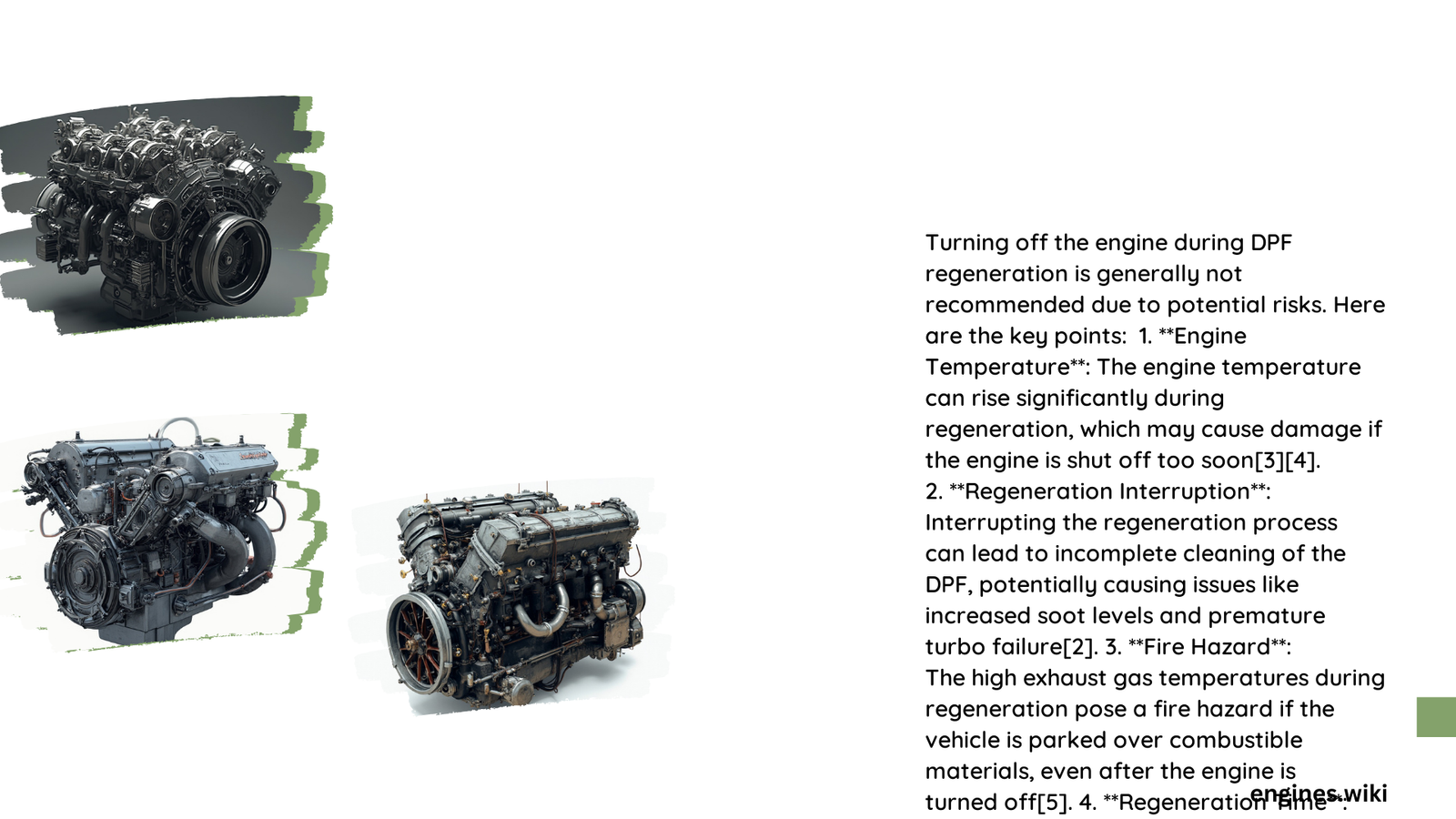Turning off the engine during DPF regeneration is generally not recommended. Diesel Particulate Filter (DPF) regeneration is a critical process that cleans the filter by burning off accumulated soot. Interrupting this process can lead to incomplete cleaning, potentially causing DPF clogging, reduced engine performance, and increased emissions. Vehicle manufacturers typically advise against stopping the engine during regeneration to ensure proper DPF maintenance and longevity.
What Happens If I Turn Off the Engine During DPF Regeneration?
Turning off the engine during DPF regeneration can have several negative consequences:
- Incomplete cleaning: The regeneration process may be interrupted, leaving soot partially burned.
- Increased soot accumulation: This can lead to faster DPF clogging in the future.
- Potential DPF damage: Thermal shock from sudden cooling can harm the DPF’s ceramic elements.
- Reduced engine performance: The engine may enter a ‘safe’ or ‘limp’ mode to protect itself.
- Higher emissions: Incomplete regeneration can result in increased exhaust emissions.
Are There Any Scenarios Where Turning Off the Engine is Permissible?

While it’s generally not advisable, there might be rare situations where turning off the engine during DPF regeneration is unavoidable:
- Emergency situations
- When instructed by a qualified mechanic
- If the vehicle manual explicitly states it’s safe to do so (rare)
However, these scenarios are exceptions rather than the rule. Always consult your vehicle’s manual or a professional before interrupting the regeneration process.
What Are the Long-Term Effects of Interrupting DPF Regeneration?
Consistently interrupting DPF regeneration can lead to several long-term issues:
- Premature DPF failure
- Increased maintenance costs
- Reduced fuel efficiency
- More frequent forced regenerations
- Potential engine damage
Let’s break down these effects in more detail:
| Effect | Description | Potential Cost |
|---|---|---|
| Premature DPF failure | Frequent interruptions can lead to DPF clogging and eventual failure | £1,000+ for replacement |
| Increased maintenance | More frequent servicing and cleaning may be required | £250+ per forced regeneration |
| Reduced fuel efficiency | Engine operates less efficiently with a clogged DPF | Varies, but can be significant over time |
| More forced regenerations | Manual regenerations may be needed more often | Time cost + potential service fees |
| Engine damage | In extreme cases, a clogged DPF can lead to engine issues | Potentially thousands for major repairs |
How Does DPF Regeneration Work?
Understanding the DPF regeneration process can help explain why interrupting it is problematic:
- Passive Regeneration:
- Occurs naturally during normal driving conditions
- Requires sustained high exhaust temperatures
-
Typically happens during highway driving
-
Active Regeneration:
- Initiated by the engine management system
- Involves injecting additional fuel to increase exhaust temperature
-
Can take 10-15 minutes to complete
-
Forced Regeneration:
- Performed by a mechanic when passive and active regeneration fail
- Uses diagnostic tools to manually initiate the process
- Can take up to 30 minutes
Interrupting any of these processes, especially active regeneration, can leave the DPF partially cleaned and more prone to clogging.
What Are the Signs That DPF Regeneration is in Progress?
Recognizing when DPF regeneration is occurring can help you avoid turning off the engine at the wrong time. Look for these signs:
- Increased engine noise or fan speed
- Higher fuel consumption
- A slight change in exhaust smell
- Dashboard warning light (on some vehicles)
- Elevated idle speed
If you notice these signs, it’s best to continue driving until the process completes, typically 10-15 minutes for active regeneration.
How Can I Ensure Successful DPF Regeneration?
To promote successful DPF regeneration and avoid the need to interrupt the process:
- Drive at highway speeds regularly (above 40 mph for 10-15 minutes)
- Avoid short trips and frequent start-stops
- Use the recommended engine oil and fuel
- Address any engine performance issues promptly
- Follow the manufacturer’s maintenance schedule
What Should I Do If I Accidentally Turn Off the Engine During Regeneration?
If you inadvertently turn off the engine during DPF regeneration:
- Restart the engine as soon as possible
- Drive at highway speeds for at least 15-20 minutes
- Monitor for any warning lights or unusual behavior
- If problems persist, consult a mechanic or your dealership
Are There Any Vehicles That Allow Engine Shutdown During DPF Regeneration?
Most vehicles do not allow or recommend engine shutdown during DPF regeneration. However, some modern vehicles with advanced DPF systems might have safeguards in place. Always consult your vehicle’s manual for specific guidance.
What Are the Alternatives to Turning Off the Engine During DPF Regeneration?
Instead of turning off the engine during DPF regeneration, consider these alternatives:
- Continue driving until the process completes
- If stopping is necessary, keep the engine idling
- Plan your trips to include regular highway driving
- Use a DPF cleaning additive (consult your manual first)
- Schedule regular maintenance to prevent DPF issues
In conclusion, it’s best to avoid turning off the engine during DPF regeneration whenever possible. This ensures the longevity of your DPF, maintains engine performance, and prevents potential costly repairs. Always prioritize completing the regeneration process for the health of your vehicle’s exhaust system.
References:
1. DPF regeneration for dummies – Auto Expert John Cadogan
2. DPF Regen Failing Explained – Diesel Laptops
3. A Quick Guide to the Diesel Particulate Filter (DPF). | Toyota NZ
4. DPF Regeneration – What You Need To Know | Autobutler
5. DPF Regeneration: Everything You Need to Know | Evans Halshaw
